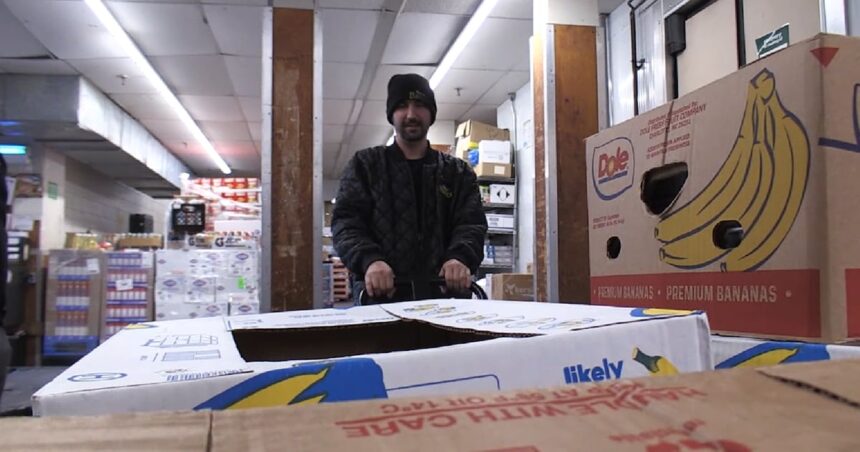The morning rush at a London, Ontario grocery store tells a familiar story. Staff meticulously inspect produce, removing items with slight blemishes despite their perfect edibility. Until recently, this food would have headed straight to landfill. Today, it takes a different journey.
“Last year alone, we redirected over 127,000 pounds of perfectly good food that would have otherwise gone to waste,” explains Heather McCann, coordinator of the London Food Coalition. The organization now connects with 23 grocery partners across the city, transforming potential waste into meals for Londoners facing food insecurity.
This paradigm shift in food recovery represents a growing movement across Canadian municipalities struggling with twin crises: mounting food waste and increasing hunger. London’s approach has become particularly noteworthy for its community-driven framework.
At the Glen Cairn Community Resource Centre, staff member Jamie Seabrook sorts through the day’s collection – slightly bruised apples, day-old bread, and surplus dairy products approaching best-before dates. “The quality is excellent. These items were on store shelves yesterday,” he notes while organizing items for the centre’s food bank clients.
The system works through a coordinated network of refrigerated vans that collect unsold food from participating retailers daily. Volunteers then sort and redistribute these items to over 30 community organizations serving vulnerable populations throughout the city.
According to Food Banks Canada, usage rates have increased by nearly 35% nationwide since 2019, with similar trends in London. The London Food Bank reports serving approximately 3,800 families monthly – roughly 9,000 individuals – marking a significant increase from pre-pandemic levels.
What distinguishes London’s program is its focus on perishable, nutritious foods rather than just shelf-stable donations. “Access to fresh produce and proteins makes an enormous difference in people’s health outcomes,” says Dr. Martha Cohen, a public health nutritionist who has studied food security initiatives across Ontario. “Many food assistance programs historically focused on non-perishables, which often meant high-sodium, high-sugar options.”
The environmental impact is equally significant. Organic waste in landfills produces methane, a greenhouse gas approximately 25 times more potent than carbon dioxide. The City of London estimates the program diverted nearly 64 tonnes of food waste from landfills last year alone, reducing the equivalent of 122 tonnes of carbon emissions.
Behind the statistics are real Londoners experiencing tangible benefits. Maria Thompson, a single mother of three who recently began using the services at Glen Cairn, describes the difference fresh food makes. “Before, I was stretching canned goods for days. Now my kids are eating strawberries and yogurt – things I simply couldn’t afford to buy.”
The program’s success hasn’t come without challenges. Coordination between multiple stakeholders requires precise logistics, and transportation remains a constant hurdle. “We’re always in need of more volunteer drivers and fuel support,” McCann admits. “The distance between donation points and distribution centres means significant transportation costs.”
Funding represents another ongoing concern. While the program operates primarily through volunteer power, refrigeration equipment, fuel, and administrative costs require sustainable support. The London Food Coalition currently operates through a combination of municipal grants, private donations, and support from participating retailers.
Glen Allen, manager of a participating Loblaws location, explains the retailer perspective: “This program actually saves us money on waste disposal while helping the community. It’s genuinely a win-win.” Allen notes that staff morale has improved since implementing the program, with employees expressing satisfaction that unsold food goes to those in need.
The London model has drawn attention from other mid-sized Canadian cities facing similar challenges. Delegations from Kitchener-Waterloo, Windsor, and Kingston have visited to study the coalition’s approach, particularly its hub-and-spoke distribution system that enables same-day redistribution of perishable items.
Provincial officials have also taken notice. Last month, Ontario’s Ministry of Environment, Conservation and Parks announced a $3.5 million expansion in funding for similar food recovery initiatives across the province, specifically citing London’s program as an exemplar.
Local politicians have embraced the program’s success. “This initiative demonstrates how community-driven solutions can address complex problems more effectively than top-down approaches alone,” states London city councillor Jesse Helmer, who helped secure initial funding for the coalition’s first refrigerated van in 2018.
As food inflation continues to squeeze household budgets across Canada, such programs may become increasingly essential components of community support systems. Statistics Canada reports food prices have increased by approximately 5.9% over the past year, with fresh produce often seeing the steepest increases.
For London’s most vulnerable residents, the redistribution program offers more than just calories – it provides dignity. “Being able to choose fresh food rather than just accepting whatever’s available makes a tremendous difference in how people feel about seeking help,” explains social worker Diane Franks, who works with seniors accessing the program.
As the coalition enters its fifth year of operation, organizers are looking toward expansion. Plans include developing a centralized warehouse facility that could extend food preservation capabilities and potentially process surplus produce into freezable meals and preserved goods.
For now, the daily work continues – one grocery store, one community centre, and one meal at a time – proving that sometimes solving big problems starts with saving small items that would otherwise be thrown away.






